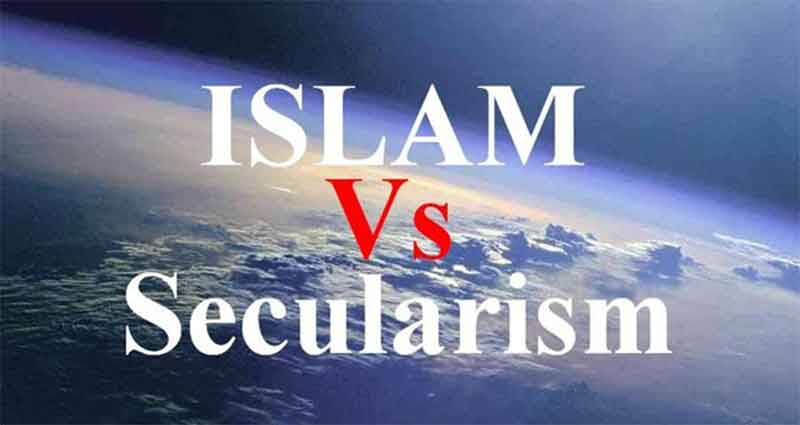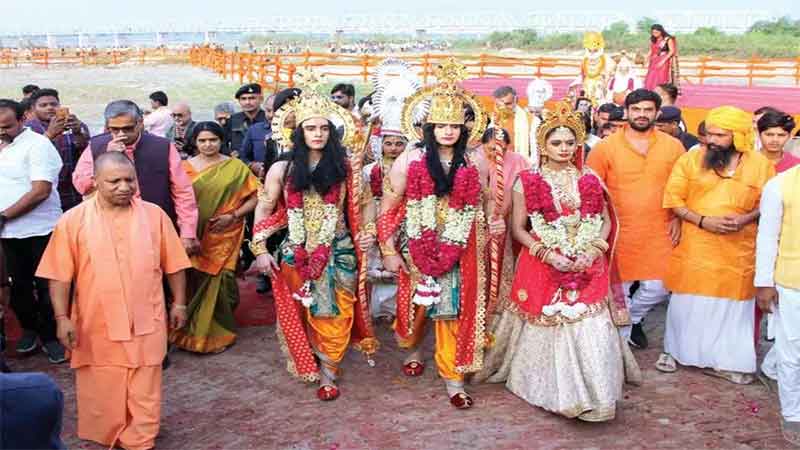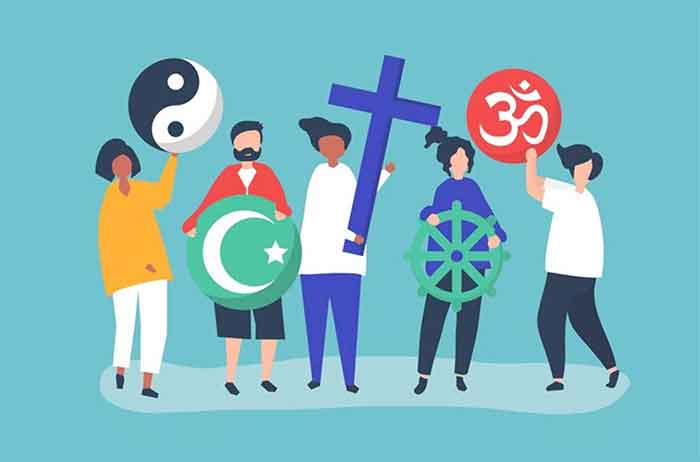by Jaspreet Kaur & Aarif Rashid Malik

In order to understand “secularism” it is essential to understand various terms, like pluralism, liberalism, associated with it and the term as applied in the West and countries like India.
“Secularsim” is most commonly defined as the separation of religion from civic affairs and the state, and may be broadened to the need to remove or to minimize the role of religion in any public sphere. The term “secularism” has a broad range of meanings, and may connote anticlericalism, atheism, naturalism, non-sectarianism, neutrality on topics of religion, or the complete removal of religious symbols from public institutions.
Some of the states that are often considered “constitutionally secular” are the United States, France (Laïcité), Turkey, India, Mexico, and South Korea, though none of these nations have identical forms of governance with respect to religion. In France, and Turkey, as in India, the emphasis is more on equality before law and state neutrality rather than blanket separation. The purposes and arguments in support of secularism range from it being a crucial element of ‘modernization’, or that religion and traditional values are divisive, to the claim that it is the only guarantor of free religious exercise.
The word “secularism” was coined in 1851 by the agnostic British writer George Holyoake who provided a definition of secularism “much akin to modern definitions of humanism… broader than just atheism.” He edited a secularist paper, the Reasoner, from 1846 to June 1861, followed by the Secular Review in August 1876.
A major impact on the idea of state religious liberty came from the writings of John Locke, one of the most influential of Enlightenment thinkers and commonly known as the “Father of Liberalism”, who in his A Letter Concerning Toleration, argued in favour of religious toleration. He argued that government must treat all citizens and all religions equally, and that it can restrict actions, but not the religious intent behind them.
Secularism is most often associated with the Age of Enlightenment in Europe and it plays a major role in Western society. The principles, but not necessarily the practices, of separation of church and state in the United States and several European countries draw heavily on secularism.
Though Secularism, defined as separation of church and state is a Western concept, secular states also existed in the Islamic world during the Middle Ages. A number of scholars have argued that a separation of religion and political power is not inconsistent with early Islamic history. The Sudanese-born Islamic scholar Abdullahi Ahmed An-Na’im has argued that a secular state built on constitutionalism, human rights and full citizenship is more consistent with Islamic history than modern visions of an Islamic state.
In India, due to the religious dimensions of various communities, the rulers saw no dichotomy between ‘secular’ matters and cultural-religious matters. Mughal Emperor Akbar (1556-1605), established the Sufi mystic principle of Sulh-i-kul (Arabic for “peace be with all”). It described a peaceful and harmonious relationship among different religions.
Maharaja Ranjit Singh (1780 -1839) successfully established a secular rule in the Punjab. This secular rule respected members of all races and religions and it allowed them to participate without discrimination in his durbar and he had Sikh, Muslim, Hindu and later even European representatives in his durbar. Ranjit Singh also extensively funded education, religion, and arts of various different religions and languages.
The post-independence constitutional adaptation of secularism in India is “equal respect for all religions”. This can also be equated to “pluralism”, which accepts and affirms the diversity within a political body, and permits the peaceful coexistence of different interests, convictions, and lifestyles. However, pluralism is a broader concept. We see plurality among ourselves in terms of theories, philosophies, societal tradition, thoughts, opinion, culture, race, ethics and several other aspects. People of a true pluralistic nation become more broad-minded, tolerant and allowed others enough space. An earlier version of political pluralism was a strong current in the formation of modern social democracy – to balance socialist and capitalist ideals. This changed to the pluralists advocating pluralism based on the pre-existing traditions and interests of a given society, and the political structure most likely to harmonize these factors.
Both secularism and pluralism wish to prevent any one religion from dominating the public sphere. Both would like to safeguard the public square from it being dominated by a majority religion. However, pluralism is the idea that all religions are equally valid; secularism arose in a society pervaded by the idea that only one religion is valid. From a secular perspective the state should be kept away from that one religion because religion itself is no longer considered a valid way of looking at life any more the way it used to be. From a pluralist perspective, however, the state must be kept away from any one religion because all religions are valid.
Liberalism, which spread rapidly after the French Revolution of 1789, supports individual rights (including civil rights and human rights), liberal democracy, secularism, pluralism, rule of law, economic and political freedom, freedom of speech, freedom of the press, freedom of religion, private property and a market economy. Liberalism too became a distinct movement in the Age of Enlightenment, and sought to replace the norms of hereditary privilege, state religion, absolute monarchy, the divine right of kings and traditional conservatism with representative democracy and the rule of law. Liberals also ended mercantilist policies, royal monopolies and other barriers to trade, instead promoting free trade and markets.
Secularism is not atheism
Atheism is a lack of belief in gods. Secularism simply provides a framework for a democratic society. Atheists have an obvious interest in supporting secularism, but secularism itself does not seek to challenge the tenets of any particular religion or belief, neither does it seek to impose atheism on anyone.
Secularism is simply a framework for ensuring equality in all aspects of the society – in politics, education, the law and elsewhere – for believers and non-believers alike.
Contextualising Indian Secularism
Architects of the Indian nation had adopted secularism to shun the communalisation of Indian society, which had one of its worst manifestation in the violence during the time of partition of 1947.
At the time, there were two other competing visions for how the state should handle religion, namely Hindu nationalism and Hindu traditionalism. The former believed that Indian identity was embodied in Hinduism since Hindus were in majority and the original inhabitants of India. By contrast, Hindu traditionalists, the right wing of the Congress Party, paid more attention to cultural features, such as the linguistic pre-eminence of Hindi over Urdu, which many Indians regarded as a foreign language. In spite of the pressure they exerted, Nehru and the head of the assembly’s drafting committee, B. R. Ambedkar, argued successfully in favour of a form of “composite culture” that is, the “Indian secularism.”
It was decided to have a secular state in India in order to preserve and sustain the spirit of vibrant diverse culture and tradition in India. The doctrine of secularism was also incorporated with the notion that the state will not prioritise any particular religion in India. In other words, the state will not discriminate against any religion in the country and equal rights will be given to minorities in India to profess and propagate their religion in a secular spirit. That is, there is no religious other, only another.
Nehru fought against all forms of communalism (whether Hindu, Muslim, or Sikh), not against religion per se, as evident from the fact that he never intended to separate politics and religion, as happened in the ideas of laïcité (a form of secularism that strictly forbids any government involvement in religious affairs), in France and Atatürk’s Turkey.
Between the 1950s and the 1970s, India’s secular model seemed to work reasonably well. Although not implemented evenly, Section 123 of the Representation of the People Act of 1951, the law that guides the conduct of elections in India, forbids politicians from campaigning on religious themes for this reason.
However, the Indian governments, over the years, especially since the 1980s, have not maintained a clear cut distance from all religions and have favoured one over the other, usually the majority religion. Rajeev Bhargava, a political theorist, terms India’s secular approach as one of “principled distance”, and not equidistance. At the same time, one significant stream of secularism has come from religious minorities who see governmental and political secularism as integral to the preservation of equal rights.
Nehru and Secularism in India
The first prime minister of India Pandit Nehru, who was at the helm of political decision-making in India at the time of inception of the Republic asserted that the state needed to distance itself from religion. However, Nehru and Gandhi accepted it for different reasons. For Nehru, no religion was true, hence the state should avoid it – dharma-nirapeksa; for Gandhi, all religions were true, hence the state could not espouse any one religion – sarva-dharma-sama-bha-va.
It was the Nehruvian understanding of secularism that was embodied in the Constitution adopted in 1950, and the word “secular” was inserted into the Constitution in 1976 by Indira Gandhi. Nehru often pronounced that India’s composite culture was one of its greatest strengths.
In this context one needs to also consider the term ‘scientific temper’, coined by Jawaharlal Nehru. He defined it as an attitude of logical and rational thinking. There is a significant relationship between scientific temper and the idea of secularism. The practice of secularism derives strength from the ideas of science while science can best motivate change in a society that appreciates secularism.
While in its European context, secularism embodied three ideas: One, that the role of religion will continue to decline in public life, with the attendant hope that its place will be taken over by rational and scientific thinking; two, that religion will become an increasingly private affair; and three, that the state will have no formal religion of its own.
In the Indian context, the concept of the secular state entails three meanings. First, there is freedom of religion or irreligion for all. Second, the state will honour all faiths equally. Third, the state will not be attached to any faith or religion, so that no religion assumes the status of a state religion.
Shrinking of secularism in India
While, as explained, the word secularism admits many shades of meaning, pluralism might also admit many shades of meaning, especially in a neo-Hindu context. Hindu fundamentalists oppose secularism, often claiming that there is a “radical secularist” ideology being adopted in our current day and they see secularism as a threat to “Hindu rights” as well as to national security. Despite being a constitutionally secular country, some Hindutva organisations demand for the declaration of a “Hindu state” (Hindu Rashtra) within India.
Even before Hindutva forces began attacking India’s secular tradition, the Congress Party had already started undermining secularism by appeasements for the support of different vote banks and by stoking divisive issues of social identity. In addition, the various institutions, including the judiciary, especially at the lower levels, has adopted a majoritarian undertone on certain controversial cases.
Indira Gandhi sought to capitalize on religious differences in several blatantly cynical ways. Among other things, she recognized Aligarh Muslim University as a minority institution; Jarnail Singh Bhindranwale to destabilize the Akali Dal, a rival political party in Punjab, which eventually resulted in Operation Bluestar and the Sikh genocide of 1984; and inaugurated the Bharat Mata Mandir, a temple constructed in 1983 with the support of the Vishva Hindu Parishad (VHP), also known as the World Hindu Council.
Rajiv Gandhi, in the course of handling the divisive Shah Bano case, sought to invoke sharia as the template for Muslim communal law in India. This political strategy was looked at as appeasement of Muslims and was termed as Hindu nationalists pseudo-secularism by the Hindu-nationalists. Over the last two years, the Congress Party has indulged in what some call “soft Hindutva.”
Also, there has always been underrepresentation of Muslims among Congress candidates, although the BJP’s underrepresentation of Muslims is far more significant. The Congress Party, infact, has never nominated many Muslim candidates, even under Nehru and Indira Gandhi, because of the steady influence of Hindu traditionalists within the party at the state level. However, it has managed to retain its secular image, largely due to the secular credentials of its top leaders.
However, exploiting the several follies of the Congress Party, Hindu nationalists (Sangh Parivar – various organisations under the RSS) began accusing it of playing vote bank politics with Muslims. But, at the same time, the RSS played the same card with Hindu voters and decided to turn the majority community into a vote bank.
The demolition of Babri Masjid was a clear reflection of the Sangh Parivar’s anti-secular agenda, which remains its core identity today. For the RSS, turning India into a Hindu Rashtra, it becomes necessary to eradicate, what they consider foreign influences, as exemplified by the renaming of cities that previously had Islamic names, such as Allahabad renamed as Prayagraj. Since 2014, when BJP came to power, groups of Hindu vigilantes have taken upon themselves to discipline minorities as gau rakshaks or protection of their women by way of love jihad. The influence of the Sangh Parivar has grown at the grassroots level grows with the tacit support of the BJP-dominated state apparatus.
BJP also fulfilled its long standing electoral promises of building the Ram temple at Ayodhya; abrogation of article 370 of Jammu & Kashmir; and pushing for the uniform civil code (UCC), which had been a key poll plank of the BJP under Atal Bihari Vajpayee during the 1998 elections. The UCC, which comes under Article 44 of the Constitution of India, proposes to introduce personal laws that would apply to all citizens equally, irrespective of their religion, gender, caste, etc. It essentially refers to a common set of laws governing personal matters such as marriage, divorce, adoption, inheritance, and succession. At present, the personal laws of various communities are largely governed by their religion.
BJP also tried to enforce the Citizenship Amendment Act (CAA). The amended act aims to give citizenship to religiously persecuted minorities from Pakistan, Bangladesh and Afghanistan, using religion as a qualifier.
The recent statements and tweets about the Prophet, by the BJP spokesperson Nupur Sharma and Navin Jindal, termed by the party as “fringe elements” has led to an outrage on social media and a huge backlash in West Asia resulting in summoning of Indian envoys by the various governments and seeking apology from India. “Allowing such Islamophobic remarks to continue without punishment, constitutes a grave danger to the protection of human rights and may lead to further prejudice and marginalization, which will create a cycle of violence and hate,” Qatar said.
Secularism, as well as pluralism may be at increasing risk as religious identity has now become a way to define one’s legitimacy even as a citizen.
Conclusion
The primary reason of decline of “Indian secularism” is largely connected to religious identification, declining pluralism, and diminishing state secularism. Majoritarianism of the BJP has also spread to election campaigns of opposition parties.
Rajeev Bhargava says, “It has been persistently misused and abused. Distinguishing it from constitutional political secularism, I called this abused entity, ‘party-political secularism’… Indian constitutional secularism is swallowed up by this party-political secularism, with not a little help from the Opposition, media and judiciary.”
The constitution sought to address the most pressing issues: establishing fundamental civil rights, disabling the hierarchical caste system, creating equal opportunity and economic growth, decreasing economic inequality, addressing religious divides by creating a secular government, and carrying out free and fair elections. Caste and Religious divides, political corruption, and, more recently threats to media freedom and civil society have raised concerns of India’s democratic trajectory. Between 2016 and 2018 India fell in Freedom House’s index from “free” to “partly free,” the Economist Intelligence Unit dropped India’s ranking and rating to a “flawed democracy” between 2016 and 2017, and Reporters without Borders dropped India’s ranking 3 places regarding media freedom and censorship.
Indian secularism is a concept has a longer, distinguished place in the history of Indian civilization. For centuries, several rulers have promoted the coexistence of India’s religious communities. Emperor Ashoka, Mughal Emperor Akbar and Maharaja Ranjit Singh did so. This tradition that culminated in Gandhism. In fact, Indian secularism is the by-product of a whole civilization, as the writer, Nayantara Sahgal, remarked: “We are unique in the world that we are enriched by so many cultures, religions. Now they want to squash us into one culture. So it is a dangerous time. We do not want to lose our richness. We do not want to lose anything . . . all that Islam has brought us, what Christianity has brought us, what Sikhism has brought us. Why should we lose all this? We are not all Hindus but we are all Hindustani.”
For secularism to get back on track in India it is essential for it to become a ‘socially-driven’ movement rather than a ‘politically-led’ project. B.R. Ambedkar claimed that when communities view each other as enemies, they tend to close ranks. It then becomes important for the focus to shift to self-introspection, that is, a look at reforms needed within each community, allowing for discussions, debates and dissent. This would eventually help eradicate the inter-religious and majority-minority differences.
Jaspreet Kaur is an architect-urban designer, New Delhi
Aarif Rashid Malik has done his Masters in Political Science from the University of Kashmir. [email protected]
















































